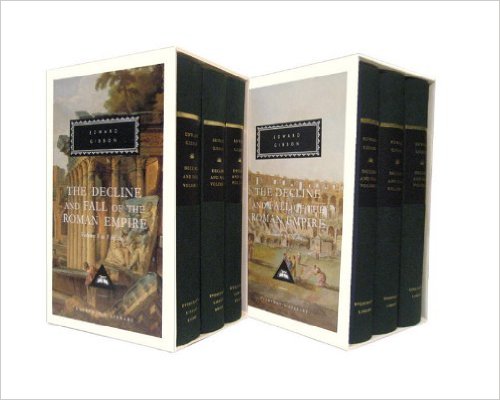The Decline and Fall of the Roman Empire, vol. 1-6 by Edward Gibbon (Author)

'The Decline and Fall of the Roman Empire, vol. 1-6'
By Edward Gibbon (Author)
Purchase Book:
Amazon.com
Amazon.co.uk
Description:
Edward Gibbon's six-volume History of the Decline and Fall of the Roman Empire (1776-88) is among the most magnificent and ambitious narratives in European literature. Its subject is the fate of one of the world's greatest civilizations over thirteen centuries - its rulers, wars and society, and the events that led to its disastrous collapse.
This set is the complete 6 volumes collected into 2 boxed sets, in beautiful, enduring hardcover editions with elegant cloth sewn bindings, gold stamped covers, and silk ribbon markers.
'A masterpiece of historical penetration and style.'
By Edward Gibbon (Author)
Purchase Book:
Amazon.com
Amazon.co.uk
Description:
Edward Gibbon's six-volume History of the Decline and Fall of the Roman Empire (1776-88) is among the most magnificent and ambitious narratives in European literature. Its subject is the fate of one of the world's greatest civilizations over thirteen centuries - its rulers, wars and society, and the events that led to its disastrous collapse.
This set is the complete 6 volumes collected into 2 boxed sets, in beautiful, enduring hardcover editions with elegant cloth sewn bindings, gold stamped covers, and silk ribbon markers.
'A masterpiece of historical penetration and style.'
(Printing and the Mind of Man)
'I can recollect no historical work from which I have received so much instruction ... It is a work of very high merit indeed.'
(William Robertson)
________________________________________________
'I can recollect no historical work from which I have received so much instruction ... It is a work of very high merit indeed.'
(William Robertson)
________________________________________________
Edward Gibbon (8 May 1737 – 16 January 1794) was an English historian and Member of Parliament. His most important work, The History of the Decline and Fall of the Roman Empire, was published in six volumes between 1776 and 1788. The Decline and Fall is known for the quality and irony of its prose, its use of primary sources, and its open criticism of organised religion.
Gibbon returned to England in June 1765. His father died in 1770, and after tending to the estate, which was by no means in good condition, there remained quite enough for Gibbon to settle fashionably in London at 7 Bentinck Street, independent of financial concerns. By February 1773, he was writing in earnest, but not without the occasional self-imposed distraction. He took to London society quite easily, joined the better social clubs, including Dr. Johnson's Literary Club, and looked in from time to time on his friend Holroyd in Sussex. He succeeded Oliver Goldsmith at the Royal Academy as 'professor in ancient history' (honorary but prestigious). In late 1774, he was initiated a freemason of the Premier Grand Lodge of England. And, perhaps least productively in that same year, he was returned to the House of Commons for Liskeard, Cornwall through the intervention of his relative and patron, Edward Eliot. He became the archetypal back-bencher, benignly "mute" and "indifferent," his support of the Whig ministry invariably automatic. Gibbon's indolence in that position, perhaps fully intentional, subtracted little from the progress of his writing.
After several rewrites, with Gibbon "often tempted to throw away the labours of seven years," the first volume of what would become his life's major achievement, The History of the Decline and Fall of the Roman Empire, was published on 17 February 1776. Through 1777, the reading public eagerly consumed three editions for which Gibbon was rewarded handsomely: two-thirds of the profits amounting to approximately £1,000. Biographer Leslie Stephen wrote that thereafter, "His fame was as rapid as it has been lasting." And as regards this first volume, "Some warm praise from David Hume overpaid the labour of ten years."
Volumes II and III appeared on 1 March 1781, eventually rising "to a level with the previous volume in general esteem." Volume IV was finished in June 1784; the final two were completed during a second Lausanne sojourn (September 1783 to August 1787) where Gibbon reunited with his friend Deyverdun in leisurely comfort. By early 1787, he was "straining for the goal" and with great relief the project was finished in June. Gibbon later wrote:
It was on the day, or rather the night, of 27 June 1787, between the hours of eleven and twelve, that I wrote the last lines of the last page in a summer-house in my garden. ... I will not dissemble the first emotions of joy on the recovery of my freedom, and perhaps the establishment of my fame. But my pride was soon humbled, and a sober melancholy was spread over my mind by the idea that I had taken my everlasting leave of an old and agreeable companion, and that, whatsoever might be the future date of my history, the life of the historian must be short and precarious.
Volumes IV, V, and VI finally reached the press in May 1788, their publication having been delayed since March so it could coincide with a dinner party celebrating Gibbon's 51st birthday (the 8th). Mounting a bandwagon of praise for the later volumes were such contemporary luminaries as Adam Smith, William Robertson, Adam Ferguson, Lord Camden, and Horace Walpole. Smith remarked that Gibbon's triumph had positioned him "at the very head of [Europe's] literary tribe."
_____________________________
_____________________________


Leave a comment